POSTLUDE: Fundamentals of Music (Review – From “Open Music Theory”)
34 Triads
Chelsey Hamm
Key Takeaways
- A triad is a three-note chord whose notes can be arranged in thirds. A triad can always be “stacked” so that its notes are either on all lines or all spaces.
- When a triad is stacked in its most compact form in thirds, the lowest note is called the root, the middle note is called the third, and the highest note is called the fifth.
- There are four qualities of triad. A major triad's third is major and its fifth is perfect, while a minor triad's third is minor and its fifth is perfect. A diminished triad's third is minor and its fifth is diminished, while an augmented triad's third is major and its fifth is augmented.
- In chord symbols, major triads are represented with capital letters that correspond to the triad’s root. Minor triads have a lowercase “mi” after the letter, diminished triads have a superscript circle (o), and augmented triads have a plus sign (+). You may see other abbreviations in other contexts (a more exhaustive list is given in the Chord Symbols chapter).
- Within major and minor keys, triads have particular qualities that correspond to scale degree. These are the same in every major and minor key, which makes memorizing them useful.
- Triads are identified by their root, quality, and inversion.
Triads
The three notes of a triad can always be arranged in thirds. Example 1 shows two triads, each written both melodically and harmonically. The first triad is on three adjacent spaces, while the second triad is on three adjacent lines. A triad can always be “stacked” so that its notes are either on all lines or all spaces. When a triad is stacked in its most compact form (measures 2 and 4 of Example 1), it looks like a snowperson (see Example 2). Just as a snowperson consists of a bottom, middle, and head, a triad consists of lowest, middle, and upper notes.
https://musescore.com/user/32728834/scores/6839451/embed
Example 1. Two triads, shown melodically and harmonically.


Colloquially, when a triad is stacked in this fashion, we might call this “snowperson form,” but the official term is root position; this is explored more in the chapter titled Inversion and Figured Bass. As Example 3 shows, the lowest note of a triad is called the root, the middle note is called the third (a generic third above the root), and the highest note is called the fifth (a generic fifth above the root).
Triadic Qualities and Listening to Triads
There are four qualities of triad—major, minor, diminished, and augmented—which are determined by the quality of the intervals from the root to the third and the root to the fifth. These qualities are labeled in Example 4: triad qualities are shown above the staff, the quality of the fifth to the root is given in red to the left of the triad, and the quality of the third is given in blue to the right of the triad. Augmented triads are shown last because the other three types are more common in most classical and popular music.
Note that triads are named for certain important intervals they contain:
- Major and minor triads are named for the quality of their third. (Both have perfect fifths.)
- Diminished and augmented triads are named for the quality of their fifth:
- A diminished triad’s fifth is diminished. (Its third is minor.)
- An augmented triad’s fifth is augmented. (Its third is major.)
Listen carefully to the different qualities of triad in Example 4. It is common to pair expressive qualities with triads when learning what they sound like. You might think of major triads as sounding “happy,” minor triads as “sad,” diminished triads as “scary,” and augmented triads as having a “fantasy” or “mystical” sound.
https://musescore.com/user/32728834/scores/6839452/embed
Example 4. Different qualities of triads.
Chord Symbols
Chord symbols for triads include the letter name of the root and an indication of the triad’s quality, and sometimes the pitch class of the bass voice (meaning the lowest note in the chord, not any particular instrument or voice type).
A chord symbol begins with a capital letter (and, if necessary, an accidental) denoting the root of the chord. That letter is followed by information about a chord’s quality. Open Music Theory will use the following abbreviations.[1]
- Major triad: no quality symbol is added
- Minor triad: lowercase “mi”
- Diminished triad: superscript circle (o)
- Augmented triad: plus sign (+)
For example, the chord symbols C, Cmi, Co, and C+ mean a C major triad, C minor triad, C diminished triad, and C augmented triad, respectively. If the root of the chord has an accidental, include it: for example, B♭mi is the chord symbol for a B♭ minor triad, and F♯o is the chord symbol for an F♯ diminished triad.
Finally, if a pitch class other than the chord root is the lowest note in the chord, a slash is added, followed by a capital letter denoting the pitch class in the bass. This topic will be explored more in the chapter titled Inversion and Figured Bass. Example 5 first shows C major and C minor triads with their chord symbols (C and Cmi). It then shows how the chord symbol for the C minor triad changes when a note other than C is on the bottom: when E♭ is the lowest note, the chord symbol is Cmi/E♭, and when G is the lowest note, the symbol is Cmi/G.
https://musescore.com/user/32728834/scores/6839453/embed
Example 5. Four triads are shown with chord symbols.
Triad Qualities in Major and Minor
Any note of the major scale can be the root of a triad. As you can see in Example 6, which is in the key of G major, triads built on do, fa, and sol ![]() and
and ![]() in major keys are major, shown with the capital letter of the triad’s root. Triads built on re, mi, and la
in major keys are major, shown with the capital letter of the triad’s root. Triads built on re, mi, and la ![]() and
and ![]() are minor, shown with a lowercase “mi” after the capital letter of the root. Triads built on ti
are minor, shown with a lowercase “mi” after the capital letter of the root. Triads built on ti ![]() are diminished; this is shown with a superscript “o” (which you might know as the degree symbol). These triadic qualities do not change in different keys; in other words, the quality of a triad built on do
are diminished; this is shown with a superscript “o” (which you might know as the degree symbol). These triadic qualities do not change in different keys; in other words, the quality of a triad built on do ![]() will always be major in any major key.
will always be major in any major key.
https://musescore.com/user/32728834/scores/8514212/embed
Example 6. Qualities of triads in major keys.
Example 7, in the key of G minor, shows the pattern of triad quality for minor scales. Note that this example contains two triads built on sol ![]() and two built on te/ti
and two built on te/ti ![]() /
/![]() —one without the raised leading tone (“natural minor”) and one with the raised leading tone (“harmonic minor”). As you can see in Example 7, triads built on do, fa, and sol
—one without the raised leading tone (“natural minor”) and one with the raised leading tone (“harmonic minor”). As you can see in Example 7, triads built on do, fa, and sol ![]() and
and ![]() (without the raised leading tone) are minor (shown with the lowercase “mi”). Triads built on me, le, and te
(without the raised leading tone) are minor (shown with the lowercase “mi”). Triads built on me, le, and te ![]() and
and ![]() (without the raised leading tone) are major. A triad built on sol
(without the raised leading tone) are major. A triad built on sol ![]() with the raised leading tone is also major. Triads built on re and ti
with the raised leading tone is also major. Triads built on re and ti ![]() and
and ![]() (with the raised leading tone) are diminished (shown with the superscript degree symbol).
(with the raised leading tone) are diminished (shown with the superscript degree symbol).
https://musescore.com/user/32728834/scores/8456477/s/Orwx2V/embed
Example 7. Qualities of triads built on the minor scale.
Spelling Triads
To build a triad from a chord symbol, you need to be aware of the triad’s root and quality. Complete the following steps:
- Draw the root on the staff.
- Draw notes a third and fifth above the root (i.e., draw a snowperson).
- Think of (or write down) the major key signature of the triad’s root.
- To spell a major triad, write any accidentals from the key signature that apply to the notes of the triad.
- For a minor, diminished, or augmented triad, add additional accidentals to alter the chord’s third and/or fifth when appropriate.
Example 8 shows this process for a D major triad:

- The note D, the chord’s root, is drawn on the staff.
- A snowperson is drawn—an F and A, the notes a generic third and a fifth above the D.
- The key signature of D major has been recalled. D major has two sharps, F♯ and C♯.
- A sharp (♯) has been added to the left of the F, because F♯ is in the key signature of D major. No C♯ was necessary because there is no C in the chord.
Let’s complete this process for an A♭ minor triad (A♭mi), as seen in Example 9.

- The note A♭ is written because it is the root of the triad.
- A snowperson is drawn; in other words, the notes C and E are added because they are a generic third and fifth, respectively, above A♭.
- The key signature of A♭ major is recalled. A♭ major has four flats: B♭, E♭, A♭, and D♭.
- E♭ is added, because it is in the key signature of A♭ major. B♭ and D♭ are not needed, because those notes aren’t in an A♭ triad. Now we have successfully spelled an A♭ major triad (A♭, C, and E♭).
- Minor triads contain a minor third, which is one half step smaller than a major third. Therefore, our final step is to lower the chord’s third (the C) by a half step (to a C♭). Now we have an A♭ minor triad (A♭, C♭, and E♭).
Don’t forget that diminished triads have a minor third and a diminished fifth, meaning you have to lower both the third and the fifth by a half step from a major triad. An augmented triad has a major third and an augmented fifth, so its fifth must be raised by a half step from a major triad.
Identifying Triads, Doubling, and Spacing
Triads are identified according to their root, quality, and inversion; inversion is discussed in the Inversion and Figured Bass chapter, so we will focus on root and quality for now. You can identify triads in three steps:
- Identify and write its root.
- Imagine the major key signature of its root.
- Identify and write its quality.
Example 10 shows a triad for the process of identification.
https://musescore.com/user/32728834/scores/6876492/embed
Example 10. A triad for identification.
To identify this triad:
- This triad is written in its most compact form, so the root is the lowest note, D.
- The key of D major has two sharps, F♯ and C♯; we can use this information to identify the quality of the triad.
- In this triad, the F is sharp, matching the major key signature. Therefore, we can correctly identify this as a D major triad.
Let’s apply the same steps to the triad in Example 11:
https://musescore.com/user/32728834/scores/6839467/embed
Example 11. A second triad for identification.
To identify this triad:
- First, we identify and write its root, which is C♯.
- Next, we can identify and write its quality. We imagine the key signature of C♯ major, which has seven sharps (every note is sharp).
- Therefore, E and G would be sharp in the key of C♯ major, but we see that they are both natural in Example 11. Because both the third and the fifth have been lowered by a half step, this triad is diminished. We can now correctly identify this triad as a C♯o triad.
If the bottom note of a triad has an imaginary key signature (because there is a double accidental that applies to it), use enharmonic equivalence to respell the triad. The process for this will be the same as that outlined in the last section of Intervals.
Because of the principle of octave equivalence, the doubling or spacing of notes does not affect a triad’s identification. Example 12 shows several different triads and their chord symbols. As you can see, the identification of these triads is the same, regardless of octave doublings (Example 12a) or the use of open spacing with wide intervals (Example 12b). Doublings and open spacing can be combined, as seen in Example 12c. In order to identify triads with doublings and open spacing, you need to either imagine or write the notes as a triad in closed spacing without any doublings.
https://musescore.com/user/32728834/scores/6839470/embed
Example 12. Doublings do not affect chord symbols.
- Introduction to Chords (musictheory.net)
- Triad Introduction (Robert Hutchinson)
- What is a Triad? (YouTube)
- Building Triads (YouTube)
- Constructing Triads (Columbia)
- Lead-sheet Symbols (Robert Hutchinson)
- Triad Identification Practice Tool (teoria)
- Chord Ear Training (musictheory.net)
- Triad Ear Training (Tone Dear)
- Triad Ear Training (teoria)
- Triad Identification (.pdf, .pdf, .pdf, .pdf, .pdf, .pdf, .pdf, .pdf)
- Triad Construction (.pdf), pp. 2, 4, 6, 7 (.pdf), p. 9 (.pdf)
- Triads Assignment #1 (.pdf, .mcsz)
- Triads Assignment #2 (.pdf, .mcsz)
- Triads Assignment #3 (.pdf, .mcsz)
- You may see other abbreviations in other contexts (a more exhaustive list is given in the Chord Symbols chapter). ↵
Key Takeaways
- Identifying the Key: Discerning the key of a music piece requires more than just the tonic triad or a repeated chord. It's essential to understand the underlying musical markers via the defining scale degrees as overlapping, common chords in closely related keys can create ambiguity.
- Establishing the Tonal Center: The defining scale degrees in major are [latex](\hat4)[/latex] and [latex](\hat7)[/latex]. In minor, the key and mode is defined by scale degrees [latex](\hat2)[/latex], [latex](\hat4)[/latex], and [latex](\hat6)[/latex].
- Tritone Resolutions: Diatonic tritones in both major and minor modes exhibit specific melodic voice-leading tendencies.
- Role of Cadences: Cadences play a pivotal role in establishing the tonal center and the key by emphasizing the key and mode defining scale degrees, omitting neighboring keys from consideration.
- The Four Cadence Types: Authentic, Deceptive, Half, and Plagal.
- Guidelines for Better Progressions: Culminating general guidelines are provided in summary to help craft better progressions, emphasizing root progressions, chord usage, and voice leading.
Understanding Keys
How do we identify the key of a tonal music piece? Simply sounding the tonic triad or starting and concluding a musical phrase with an identical chord doesn't unequivocally confirm the key. To truly discern the key and establish a robust tonal center, our mind requires specific musical cues to form a contextual understanding. What are these auditory markers?
Consider the keys that are closely related, positioned adjacent to one another on the Circle of Fifths:
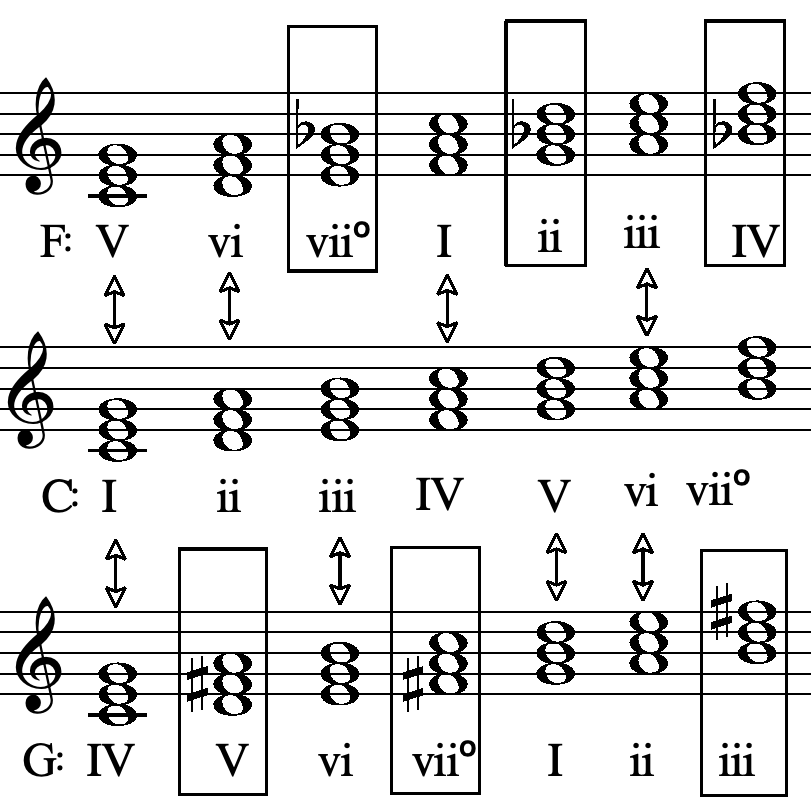

It's evident that many chords overlap among these keys. If our aim is to denote C major and we play chords common to G major, ambiguity arises between C and G major. Likewise, playing chords shared between C and F major introduces uncertainty about the key.
Establishing the Tonal Center
To differentiate and firmly set the key, one should play notes exclusive to the desired key, excluding the ones from adjacent keys on the Circle of Fifths. Investigation reveals that in the major mode, scale degrees [latex](\hat4)[/latex] and [latex](\hat7)[/latex] are pivotal for key determination. In minor mode, [latex](\hat4)[/latex] remains crucial, while the leadng-tone [latex](\hat7)[/latex] is derived from the Ascending form. The uniqueness of the minor mode is further reinforced by scale degrees [latex](\hat2)[/latex] and [latex](\hat6)[/latex]. Together, These degree pairs inherently demarcate the diatonic tritone, lending each mode its distinctive sound and attributes.
Cadences are essential here for helping us establish the tonal center and the key, as they not only conclude a harmonic sequence but also distinctly affirm the key by emphasizing the above-discussed defining scale degrees, thereby omitting neighboring keys from the tonal consideration.
Major Mode
In the major mode, the SubDominant and SuperTonic chords, sourced from the SubDominant region, encompass the defining scale degree [latex](\hat4)[/latex]. Meanwhile, chords from the Dominant region embed the leading-tone, scale degree [latex](\hat7)[/latex].
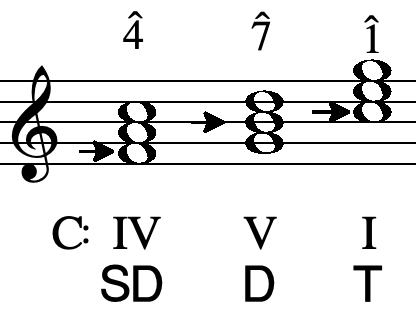

Both the Major-Minor (Dominant) Seventh chord and the Leading-Tone diminished triad encompass scale degrees [latex](\hat4)[/latex] and [latex](\hat7)[/latex]. These chords, by possessing both of the defining scale degrees, robustly fortify the tonal center in major mode.
Minor Mode
The mechanism in the minor mode parallels the major but offers more variety due to the dual nature of modern minor (i.e. the Ascending and Descending forms). Both the SubDominant and SuperTonic encompass key and mode-defining scale degrees [latex](\hat2)[/latex], [latex](\hat4)[/latex], and [latex](\hat6)[/latex]. It's noteworthy that either minor form, with a variable scale degree [latex](\hat6)[/latex]serve equally well in defining the key. In addition, when in the Ascending form, we get a leading-tone scale degree [latex](\hat7)[/latex], also providing a strong sense of definition.
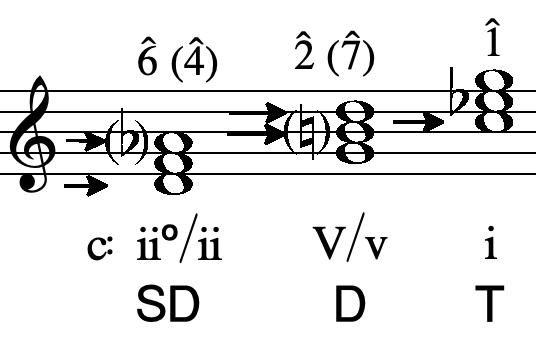
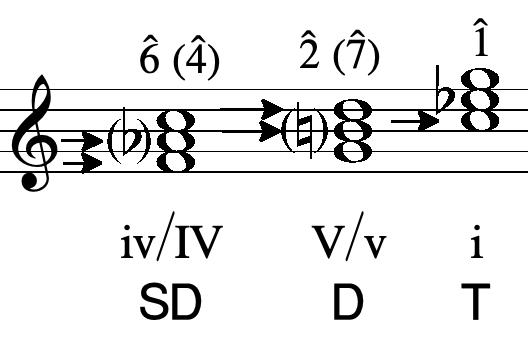
The fully diminished seventh chord, built on the raised scale degree [latex](\hat7)[/latex] from the Ascending (Harmonic) form of minor, and possessing the Natural sixth scale degree, is very potent, encapsulating all minor key and minor mode-defining scale degrees. This chord, akin to the diminished triad, can be thought of as an incomplete, rootless voicing of a ninth chord founded on the Dominant, essentially as a Dominant Seventh with an added flat ninth.
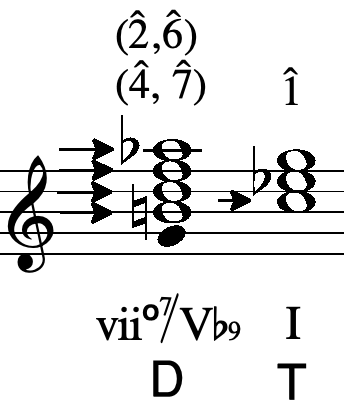
We will come back to the fully diminished seventh chord and explore its many additional possibilities in a later chapter.
Tritone and Scale Degree Melodic Tendencies
Earlier, we delved into the tendencies of the pivot tones in minor mode (tendency tones). Expanding on this concept, the diatonic tritones in both major and minor modes, demarcated by key and mode-defining degrees mentioned above, exhibit specific melodic voice-leading propensities. In both major and minor:
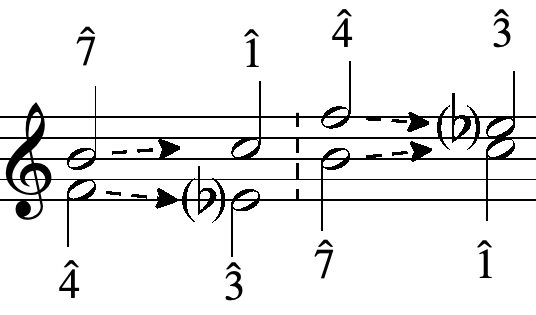
In Natural (Descending) minor:
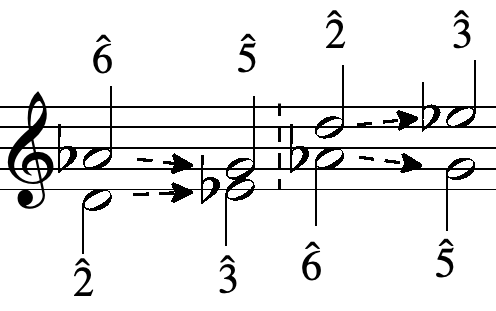
The Four Cadence Types
There are four primary types of cadences (closes) in tonal music: Authentic, Deceptive, Half, and Plagal.
Authentic
The Authentic cadence is the most definitive cadence, affirming the key and concluding on the Tonic triad. There are two types: Perfect (top voice melody terminates on the Tonic) or Imperfect (top voice melody concludes on another scale degree).
With regard to SATB voice leading, the most conclusive version of the Authentic cadence has the following:
- Each chord of the Cadence in Root Position
- The Dominant chord must be a complete chord with the root sounding (i.e. not a diminished triad or fully diminished seventh).
- Seventh chords, except for the Tonic triad, may be used, provided the voice-leading allows.
Deceptive
The Deceptive cadence seemingly sets up a closure but veers away from the Tonic chord, adding a twist to the listener's expectation. It is often a good way to both reaffirm a tonal center and key, but also provide further momentum in the musical phrase.
Half
The Half cadence offers a moment of pause, culminating on the Dominant chord rather than the Tonic, which then often moves on with a new musical phrase.
Plagal
Finally, we have the Plagal cadence, often termed the "Church" or "Amen" cadence. This cadence omits the Dominant, resulting in a less decisive closure. It is often used as an extension to an ending, after the sounding of an Authentic cadence, the purpose being to provide a more resolute conclusion. This cadence type appears regularly in popular song and contemporary pop, country and folk music.
As with the Authentic cadence, we have two forms of Plagal: Perfect and Imperfect, defined the same way as in the Authentic cadence by way of which scale degree is in the top melodic voice.
The Second Inversion (Six-Four) Triad in the Cadence
The Tonic second inversion triad, or the "Six-Four" chord, is pivotal in cadences. In the cadence. this chord is heard as a Dominant 6-4 dissonant suspension rather than a Tonic chord. How is this possible? The Dominant tone (scale degree [latex](\hat5)[/latex) is in the bass and, as we already know, any bass voice will exerts it's overtone series over the sounding notes above. Thus, the chord, by its very nature, is unstable, and it is quite easy and natural for the upper tones to have a strong pull toward neighboring tones that resolve in a root position chord (with the bass tone as the root), in essence, coming into "focus" and resonance with the harmonic series. This is one reason why we must be careful when using the second inversion triad, its inherent instability and its being at odds with the sounding tones.
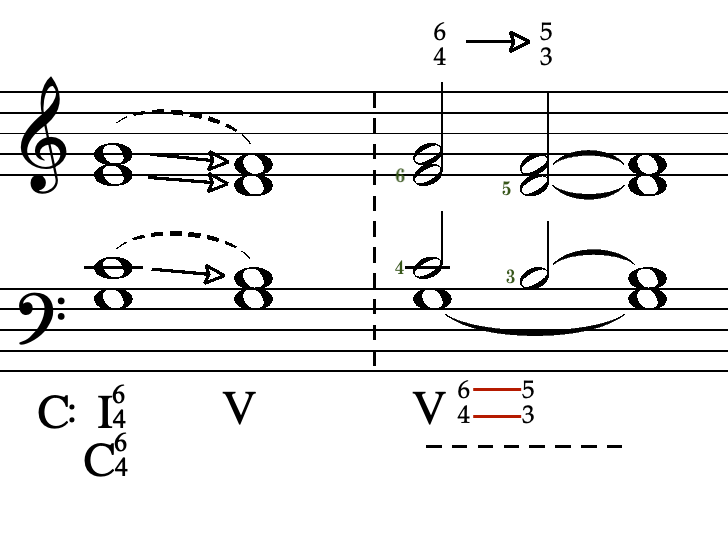
We may use this Cadential 6/4 chord in any Authentic cadence, sounding immediately after any pre-Dominant (SubDominant) chord, before the sounding of the Dominant chord. The effect is powerful and creates, as mentioned above, a sense of prolonging and tension, further elevating the final resolution to the Tonic. While it might be used as part of a Deceptive cadence, due to its power and affect, it is not well suited to such a situation unless very strongly warranted by the musical context.
Guidelines for Better Progressions
Root Progressions (in Major and Minor)
- Ascending root progressions, which move a fourth upward or a third downward, can occur anytime. However, avoid repetitive usage.
- Descending progressions, moving a fourth downward or a third upward, should be used when they contribute to an overall upward motion.
- Adjacent progressions sparingly unless specified otherwise. They aren't prohibited.
Chord Usage (in Major and Minor)
Triads
- Triads in root position are versatile and may be used anytime.
- Sixth chords enrich voice leading, especially in outer voices, and prepare dissonances. They may be used anytime (except at the start or end of a musical phrase).
- Use six-four chords cautiously. They're optimal in cadences (i.e. the Cadential 6/4) and with a moving bass-line in stepwise motion. Exercise care in all other situations.
- Diminished triads give a sense of necessity when introducing a chord, and further may be considered as a Dominant seventh chord.
Seventh Chords
- Seventh chords are as versatile as triads when prepared and resolved. They're best used where the seventh demands a specific resolution or treatment.
- Inversions of seventh chords improve voice leading.
The Minor Mode
- The careful handling of the pivot/tendency tones are essential. Incorporate the pivot tones during root progression harmonic progression outlines.
- Staying exclusively in one region (Ascending or Descending) can jeopardize the minor mode's character.
- Transitioning between regions should respect pivot tones (i.e. the four pivot tone guidelines).
- Triads may require inversions to prepare or resolve dissonances, especially with a pivot tone in bass.
- The same rules apply to seventh chords.
- After certain diminished triads, it's generally better to use the Ascending major Dominant chord (V).
- All diminished triads and their seventh chords have a distinct drive due to their dissonance.
- The augmented triad's versatility lets it transition between ascending and descending minor scales.
Voice Leading
- Avoid unmelodic intervals, especially without altered chords.
- Avoid repetitive tone progressions with the same harmony.
- Aim for a high and possibly a low point.
- Use steps and leaps for varied interval sequences, maintaining a mid-range.
- After a significant leap from the mid-range, try to return to it.
- If the mid-range is left stepwise, perhaps balance with an octave leap.
- If repetition is unavoidable, a direction change might help.
- These guidelines apply primarily to soprano and bass. If applied to middle voices, it elevates the overall smoothness. However, focusing on the outer voices is sufficient for now.
EXAMPLES: Triad Inversions and Seventh Chords in the Minor Mode
If the score above is not displaying properly you may CLICK HERE to open it in a new window.
RWU EXERCISES
Major and Minor: Chord Connection with Non-Common Chord Tones and Freer Treatment of Dissonance
Using the template below, please do the following:
- Compose at least four (4) harmonic progressions of your choice in SATB style, at least 7 to 12 chords in length:
- At least two (2) in the Major Mode (different keys of your choice) and two (2) in the Minor Mode (different keys of your choice)
- Consider the general guidelines above when constructing your phrases
- Each phrase should be planned out with root progression and harmonic regions in mind.
- Each phrase should have a good mixture of seventh chords and triads.
- Each phrase should contain one Deceptive cadence somewhere within the phrase and end with an Authentic cadence (perfect or imperfect)
- Two of your phrases should end with an Authentic cadence which uses the Cadential Six-Four chord
- Label your cadences with the following text: DC (Deceptive Cadence), IAC (Imperfect Authentic Cadence), PAC (Perfect Authentic Cadence).
- At least two (2) in the Major Mode (different keys of your choice) and two (2) in the Minor Mode (different keys of your choice)
(you must be logged into your Noteflight account to open the activity templates above)
Schoenberg Theory of Harmony Examples
Further Reading
- Schoenberg, Arnold: Theory of Harmony
- Schoenberg, Arnold: Structural Functions of Harmony





